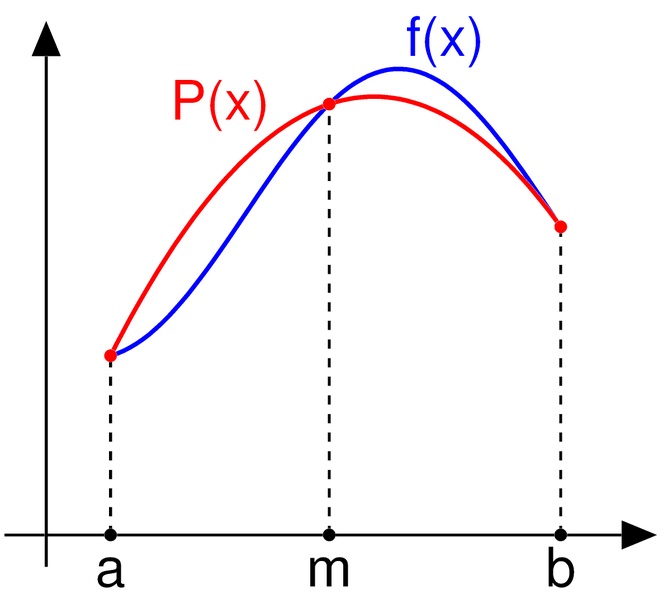117 lines
3.5 KiB
Markdown
117 lines
3.5 KiB
Markdown
---
|
||
title: Simpson's Rule
|
||
localeTitle: 辛普森的规则
|
||
---
|
||
# 辛普森的规则
|
||
|
||
在数值分析中,辛普森的规则是数值积分的方法_(定积分的数值逼近)_ 。
|
||
|
||
辛普森的规则近似于形式的整合,
|
||
|
||

|
||
|
||
哪里,
|
||
|
||
* `f(x)`称为_被积函数_
|
||
* `a` =整合的下限
|
||
* `b` =整合的上限
|
||
|
||
## 辛普森的1/3规则
|
||
|
||

|
||
|
||
如上图所示,被积函数`f(x)`由二阶多项式近似;二次插值是`P(x)` 。
|
||
|
||
接近,
|
||
|
||

|
||
|
||
将`(ba)/2`替换为`h` ,我们得到,
|
||
|
||

|
||
|
||
如您所见,上述表达式中有`1/3` 。这就是为什么,它被称为**辛普森的1/3规则** 。
|
||
|
||
如果某个函数在某些点上具有高度振荡或缺乏导数,则上述规则可能无法产生准确的结果。处理此问题的一种常见方法是将间隔`[a,b]`分解为许多小的子间隔。然后将辛普森的规则应用于每个子区间,将结果相加以产生整个区间内积分的近似值。这种方法被称为_复合辛普森的规则_ 。
|
||
|
||
假设区间`[a,b]`被分成`n`个子区间, `n`是偶数。然后,复合Simpson的规则给出,
|
||
|
||

|
||
|
||
其中**x j = a + jh** , **j = 0,1,...,n-1,n,**其中**h =(ba)/ n** ;特别地, **x 0 = a**且**x n = b** 。
|
||
|
||
#### 例:
|
||
|
||
**取下面给出的积分值,取n = 8。**
|
||
|
||

|
||
|
||
在C ++中实现Simpson的1/3规则如下:
|
||
|
||
```cpp
|
||
#include<iostream>
|
||
#include<cmath>
|
||
using namespace std;
|
||
|
||
float f(float x)
|
||
{
|
||
return x*sin(x); //Define the function f(x)
|
||
}
|
||
|
||
float simpson(float a, float b, int n)
|
||
{
|
||
float h, x[n+1], sum = 0;
|
||
int j;
|
||
h = (ba)/n;
|
||
|
||
x[0] = a;
|
||
|
||
for(j=1; j<=n; j++)
|
||
{
|
||
x[j] = a + h*j;
|
||
}
|
||
|
||
for(j=1; j<=n/2; j++)
|
||
{
|
||
sum += f(x[2*j - 2]) + 4*f(x[2*j - 1]) + f(x[2*j]);
|
||
}
|
||
|
||
return sum*h/3;
|
||
}
|
||
|
||
int main()
|
||
{
|
||
float a,b,n;
|
||
a = 1; //Enter lower limit a
|
||
b = 4; //Enter upper limit b
|
||
n = 8; //Enter step-length n
|
||
if (n%2 == 0)
|
||
cout<<simpson(a,b,n)<<endl;
|
||
else
|
||
cout<<"n should be an even number";
|
||
return 0;
|
||
}
|
||
```
|
||
|
||
## 辛普森的3/8规则
|
||
|
||
辛普森的3/8规则类似于辛普森的1/3规则。唯一的区别在于,这里,插值是一个三次多项式。 3/8规则大约是1/3规则的两倍,但它使用了一个以上的函数值。
|
||
|
||
辛普森的3/8规则规定:
|
||
|
||

|
||
|
||
将`(ba)/3`替换为`h` ,我们得到,
|
||
|
||

|
||
|
||
对于n个区间,Simpson的3/8规则(n应该是3的倍数):
|
||
|
||

|
||
|
||
其中**x j = a + jh** , **j = 0,1,...,n-1,n,**其中**h =(ba)/ n** ;特别地, **x 0 = a**且**x n = b** 。
|
||
|
||
### 更多信息:
|
||
|
||
1. [辛普森的规则](https://en.wikipedia.org/wiki/Simpson%27s_rule)
|
||
2. [辛普森的1/3规则](w3.gazi.edu.tr/~balbasi/mws_gen_int_txt_simpson13.pdf) |